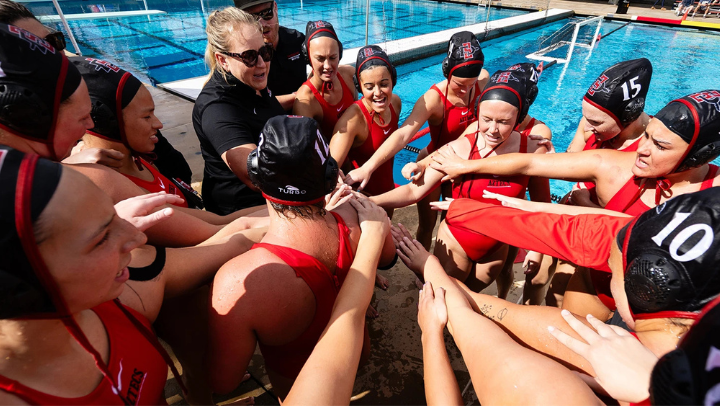Two SDSU Buildings to be Renamed in Honor of Ellen Ochoa, Charles B. Bell Jr.
East Commons and West Commons will be dedicated in recognition of a leading statistics professor, and an alumna who became an astronaut.

FOLLOW UP COVERAGE
- Bell Jr. Pavilion: Building’s New Name is a Slice of SDSU History
- Ellen Ochoa and the Multiverse of Motivation
Two prominent figures in San Diego State University history — veteran astronaut Ellen Ochoa and mathematician Charles B. Bell Jr., — will be honored this spring in the renaming of the West Commons and East Commons buildings.
Mary Bell, whose husband taught at San Diego State College from 1958 to 1966 and at SDSU from 1981 to 1992, will attend the April 3 dedication ceremony for the Charles B. Bell Jr. Pavilion, currently East Commons, with three of their children and additional family members. Bell, the first Black faculty member to achieve tenure, died in 2010. Community members are invited to RSVP to attend and honor Bell.
Ochoa, who earned an undergraduate degree in physics at SDSU in 1980, is scheduled to return to campus May 5 for the dedication ceremony of the Ellen Ochoa Pavilion, currently West Commons. Community members are invited to RSVP to attend and honor Ochoa.
The honorary namings, approved by the California State University Board of Trustees in March, are the product of a task force formed by President Adela de la Torre and a campuswide invitation for nominations in 2021, all with a special aim of increasing representation for diverse communities across campus. Each building name is to remain in place for a minimum of 15 years.
Charles B. Bell Jr.
Bell, the second Black faculty member of San Diego State College, made a name for himself in mathematics in the United States, Europe, Asia and Africa in a teaching career that spanned four decades.
Bell was born in New Orleans in 1928. Records at Xavier University of Louisiana, a historically Black private university, show he was accepted for enrollment at age 14 and graduated with a Bachelor of Science degree at 18. He went on to the University of Notre Dame, becoming the first Black student there to earn both master’s and doctoral degrees, at age 24.
He spent a few years as a research engineer at the Douglas Aircraft Company before turning to teaching in 1955. His career began at his alma mater, Xavier University, then continued at Stanford University for one year as a research associate in statistics and as a math instructor.
Bell taught at San Diego State College from 1958 to 1966, when the student body was predominantly white, with the final two years spent on sabbatical. While on leave his travels took him to such places as the Mathematics Institute in Amsterdam, the University of Madrid, the University of Vienna, the Institute of Statistics at the University of Paris, the University of Erlangen in Germany and the Mathematics Conference in Moscow.
He returned to the U.S. for positions at Case Western Reserve University, the University of Michigan, Tulane University and the University of Washington. During this period he made visits to Mombasa, Kenya, the Indian Statistical Institute in Kolkata, India and the University of Ife in Nigeria where he helped develop courses in statistics and mathematics for teachers.
Bell returned to SDSU in 1981 and retired as full professor in 1992.
“For hundreds of students in the late 1950s and early 1960s, Charles Bell was the first Black professor they ever saw,” said J. Luke Wood, SDSU vice president for Student Affairs and Campus Diversity and co-chair of the Presidential Task Force Group on Honorary Namings. “His position in the front of the classroom sent a powerful statement to students of all races, and he served as a role model in his career as one of the preeminent Black mathematicians of his time.
“The Charles B. Bell Jr. Pavilion will stand as a symbol of our pride in one of SDSU's most fondly remembered trailblazers,” Wood said.
Ellen Ochoa
With the naming of the Ellen Ochoa Pavilion, SDSU honors Ochoa’s exceptional work expanding scientific understanding, breaking barriers in a historically male-led industry, and her continued support of students and the university.
A role model for girls and underrepresented minorities who aspire to have careers in science, technology, engineering and math, Ochoa inspires students around the world to pursue their dreams and overcome potential barriers to their success. Ochoa continues to support the students at her alma mater, leaving a legacy that will positively impact the lives of students at SDSU for years to come.
Ochoa grew up in La Mesa, attended Grossmont High School and graduated from SDSU in 1980. At SDSU, she was a member of the Marching Aztecs and spent five years in the SDSU Wind Ensemble. She then went on to Stanford University to receive master’s and doctoral degrees and launch her research career. She holds three patents in her research specialty, optics.
She later joined NASA in 1988 and was selected for the astronaut corps two years later. In 1993, she flew on her first mission, becoming the first Latina in space. She flew on four shuttle missions with a total of more than 978 hours in orbit and was on the first shuttle flight to dock with the International Space Station.
Ochoa capped a 30-year career with NASA by serving as director of the Johnson Space Center in Houston, Texas. Supervising a workforce of 10,000, Ochoa was the first Hispanic director of the Johnson Space Center and only its second female leader.
In 1995, Ochoa was recognized by SDSU as Distinguished Alumna of the Year and in October 2019 she received an honorary Doctor of Science degree at a special SDSU ceremony in recognition of her role in space exploration and her commitment to the education of young people across the country.
“As a Latina, a scientist and a leader, Ellen is a pioneer who has made incredible contributions to her field, our university, and young minds around the world,” said de la Torre. “The Ellen Ochoa Pavilion will serve as a physical reminder for students of all backgrounds to break through barriers and ‘reach for the stars.’ SDSU is so proud to honor her as an alumna.”



